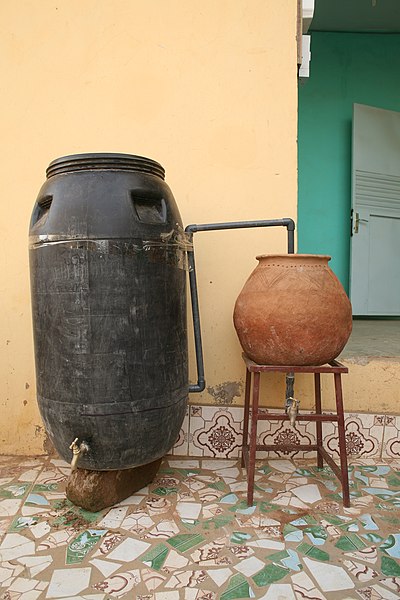I live in the US, in arguably the richest county in the US, per capita (Fairfax, VA).
Even so, there are times when no amount of money can make potable water come out of my tap. System flaws (e.g., water main ruptures), acts of God (e.g., hurricanes), or acts of man (e.g., sabotage) can all mess with the availability and/or quality of my water.
Not cool. Thirst, dysentery, and cholera are nasty things.
I'm loving the magnitude of water storage possible with common 55-gallon drums and PVC pipe or hose and hose fittings.
But if I had an infinite supply of water, I'd still have to purify it.
I have my solar oven, with a 'water pasteruization indicator (WAPI),' a little vial filled with soy wax. You put it in a container of water with the wax side up - come back after a day in the sun, and if the wax has melted and re-coalesced at the bottom, you know the water was at 200 degrees Fahrenheit for at least 10 minutes and has been pasteurized.
But I think I've come across something even better: The BioSand Filter. One of these babies can produce 5-15 gallons of clean water in an hour. Here are two videos: a funny one that doesn't really explain the physics/biology of the thing, and an earnest Christian charity one that does a great job of explaining all the details you need to understand:
Wikipedia has a nice article on the BioFilter, and there's a website called BioSandFilter.org that gives details regarding who, how, and what, for those of you who like those kinds of details.
Enjoy!

Isn't that water storage tank the same as you have in your backyard? This past week has been very rainy and every time I passed a downspout I regretted that I had no catchment system in place. The biosand filter sounds like it should be in regular use to provide the best operating quality since drying out would be counterproductive. On the other hand, it seems that a faucet valve installed at the outlet is a good idea since research seems to indicate that leaving water in the biofilter for a little longer greatly improves the quality of the output.
ReplyDeleteThe picture shows a biosand filter made from a 60 gallon pickle barrel (same thing I made my water barrel from), but in the case of the biosand filter, the pickle barrel is filled with sand.
ReplyDeleteLooking at the Wikipedia article for Slow Sand Filter, it turns out this is how the UK cleans water for London.
I think one could make an effective BioSand Filter out of a 44-gallon plastic trash bin. I will be doing that so I can filter my rain water before adding it to the fish tank. While relatively few people would want do use water from a small biosand filter in lieu of 'city water,' I think US folks could be persuaded to set one up so their pets can have clean water in case of a water outage.
On the other hand, as slow sand filtration doesn't use chemicals, there may be some who would prefer use of biosand-filtered water over municipal water supplies...